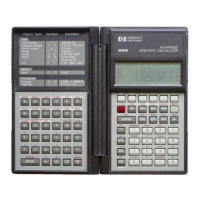User Functions.
The
programs COT, PSUM, O
....
G,
and
G
....
O are
user
functions-they
begin
with
the
command
....
and
one
or more
names, which together define
one
or more local variables, followed
by
one expression or program.
When
the
user function is stored in a vari-
able, you can use
the
name
of
the
variable in algebraics as you would
use a built-in function.
Program Structures. The
command
....
followed
by
names
and
an
expression or program is called a
local-variable
structure,
which
is
one
type of program structure. There are also
program
structures for
branching (such as
IF
...
THEN
...
ELSE
...
END)
and
looping (such
as
DO
...
UNTIL
...
END). See
chapter
26, uProgram Structures," for
descriptions. Also,
chapter
28, uProgramming Examples," contains 20
programs
that
demonstrate every
program
structure, along
with
a va-
riety of programming techniques.
Unnamed Programs. Programs
don't
need
to be stored in variables
to be useful; for examples, see HExpanding
and
Collecting Com-
pletely,"
on
page 253,
and
HDisplaying a Binary Integer,"
on
page
257.
Aigebraics
Algebraics comprise one or more functions
and
the
functions' argu-
ments;
the
arguments can be numbers, names, or subexpressions.
Algebraics are written
and
displayed in algebraic syntax, a form simi-
lar to written mathematical notation. There are two types of
algebraics, expressions
and
equations.
Expressions
In
part
1 you
used
expressions in three different ways: as data, as
functions,
and
as implicit equations.
Expressions
As
Data.
When
you calculate
with
expressions,
such
as
adding
two expressions, squaring
an
expression, or differentiating
an
expression, the result is
another
expression. In these cases
the
expres-
sions act as
data
to
be
manipulated,
independent
of
any
values
assigned to the variables.
16:
Objects
161
I

